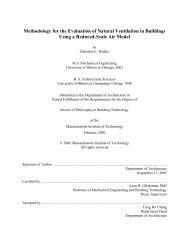Spring 2012 - Cham
Spring 2012 - Cham
Spring 2012 - Cham
You also want an ePaper? Increase the reach of your titles
YUMPU automatically turns print PDFs into web optimized ePapers that Google loves.
Wind directionNoonNorthMeshSun positionIn our test case, the wind and sun conditions arerepresentative of the UK (Gatwick) in April.The radiative heat transfer is handled by IMMERSOL.The surface emissivities are set as follows:Ground - 0.9Grass - 1.0Road - 0.5River - 1.0Building - 1.0The radiative heat loss to the sky is represented bya radiative heat loss to an external temperature of -2˚Cwith an emissivity of 1.0.It should be noted that in order to radiate 500w/m 2to an external temperature of -2˚C, the requiredtemperature is 72˚C. After around 1200 sweeps theaverage temperature over the entire ground plane justbelow the surface is 67˚C. The temperature of the roadwhich has a lower emissivity is higher, again in line withexpectation. However, given that the surfacetemperatures are not actually that high in reality, theremust be some other mechanism for heat loss.Although in this case the model is set with userdefinedinputs, both the sun and wind parameters canbe imported from an EPW weather file (eg the publicdomain Energy Plus database.)• Wind direction – East• Wind speed - 2.5 m/s at 10m• Logarithmic wind profile• Roughness height - 0.1m• Ambient temperature - 12˚C• Ground temperature - 9˚C• Sun latitude 51deg• Direct radiation 400 W/m2• Diffuse radiation 100 W/m2LitShadingSurface TempIn this example, the ground surrounding thebuildings, road, grass and river all have a Z depth of 2m.The ground temperature of 9˚C is applied at the lowerface of the ground. This represents the constant earthtemperature underground.ConclusionThe prototype heat island module demonstratesadequately the ability of PHOENICS to simulateprocesses of this type. Whilst there is alreadyconnectivity with weather mapping data bases, themodule still remains as a working template, relying uponthe user to specify appropriate materials, and theiremissivity and absorptivity values.4
3.2 CHAM Case Study – Numerical Simulationof an Air-to-Air Cross-flow Heat Exchangerby Peter Spalding, CHAM LimitedA CFD model of a cross-flow heat exchanger wascreated following receipt of a specification from theRoads and Maritime Service (RMS) of New South Wales.RMS personnel were carrying out a numerical simulationstudy to predict air flow and temperature distribution inthe air-to-air type heat exchanger installed in theirVariable Message Sign (VMS) system.RMS engineers were primarily interested in using theCFD model to calculate and predict the thermalperformance and effectiveness of the VMS heatexchanger under different boundary conditions (such asdifferent internal or external inlet temperature, differentair flow rate for exhaust fan etc) and how would theyaffect the results.FansCold InHot InFigure 3: VelocityFigure 1: Cross-Flow Heat ExchangerThe electronics inside the VMS generate heat,under normal operating conditions, due to energylosses. In summer time, the temperature inside the VMScan be as high as 75˚C. The internal re-circulating airand the external cooling air are circulated by fan at aflow rate of 600m 3 /h. The ambient temperature is 25˚Cand the temperature of internal inlet air is 75˚C. A 2%inlet turbulence intensity was specified. The size of theheat exchanger element is 0.2m X 0.2m X 0.2m and it isepoxy coated aluminium. The rest of the enclosure isaluminium alloy grade 5005 H34 with 2.0mm thickness.The above plot shows velocity of the hot air (nearright to far left) and the cooling air (near left to farright). The next plot shows the temperatures of the twoair streams, and shows the heat-exchange mechanismclearly.Cold InHot InFigure 4: TemperatureFigure 2: Cross-Flow Heat ExchangerArrayed ThinPlate objectsTwo methods of modelling the heat exchangerwere considered. The first, more simplistic, option wasto import the geometry from CAD and then apply asufficiently fine mesh to capture the 80 x 2mm crosssectionalslots in the heat exchanger. However, asecond, more pragmatic, method was adopted involvingthe replacement of this section with an array of "thinplate" objects using the same dimensions. Theadvantage of doing so is to remove the possibility ofincorrectly defined geometry and to ensure that theheat transfer is based on the correct plate thickness,whilst using a much smaller computational mesh.5
















